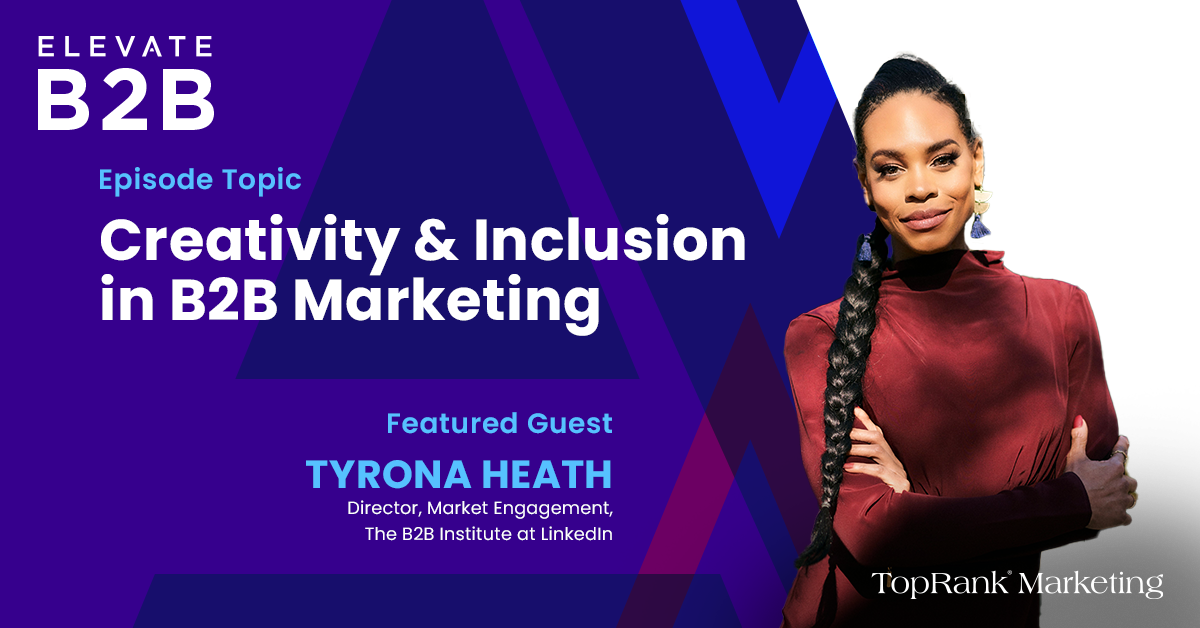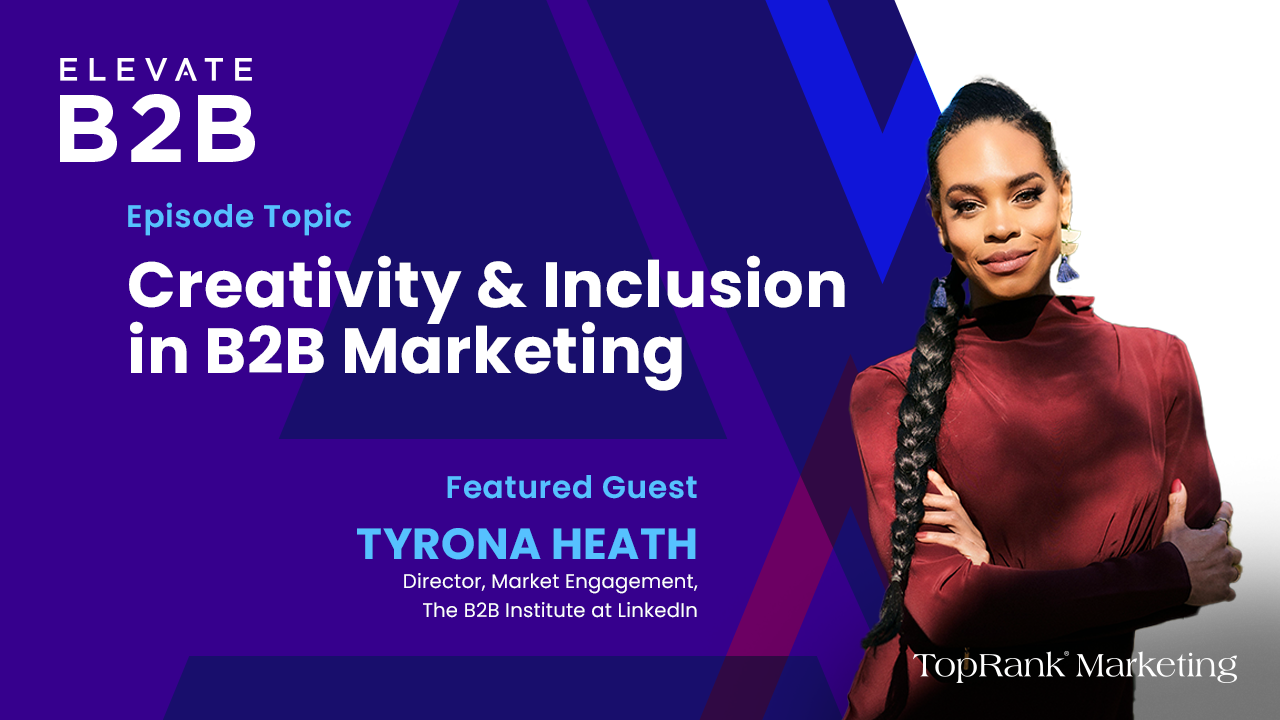|
https://ift.tt/RvCrO81
Creativity & Inclusivity in B2B Marketing with Ty Heath https://ift.tt/YMcSTxF
 Last month, we introduced our all new podcast, Elevate B2B, with the goal of elevating the B2B industry. The show features conversations that inform, include and inspire the best of B2B marketing. Each episode will feature insights from a B2B marketing leader having a conversation with our very own Lee Odden. The Elevate B2B Marketing Podcast kicked off with the queen of content herself, Ann Handley of MarketingProfs. She shared insights about the new normal of B2B marketing and emphasized the need for empathy and emotion in content marketing. Check it out here if you missed it. Featured guest, Tyrona Heath, joins this next episode of Elevate B2B to discuss creativity & inclusivity in B2B marketing. Ty is a leading B2B marketer, speaker, author, athlete and community builder who explores topics at the intersection of behavioral science, diversity, equity, inclusion and transformation. She is Director of Market Engagement at The B2B Institute at LinkedIn, which is a think tank funded by LinkedIn studying the future of B2B marketing and decision making. Ty is passionate about connecting people with information needed to make intelligent decisions, sharing research to help marketers be more productive and successful with a bit of humor. She is also a two time Olympic Trials qualifier and top B2B marketing influencer dedicated to leadership and diversity, equity and inclusion. When asked what she is move excited about in the B2B marketing world right now, Ty shared, “I feel the energy and the shift in the industry right now. It's one of the most exciting times to be a B2B marketer. More people are excited to work on B2B creative and B2B ideas and are excited about the long term relationship building aspects and the science of it.” - Ty Heath [bctt tweet="“I feel the energy and the shift in the industry right now. It’s one of the most exciting times to be a B2B marketer.” — Ty Heath @tyrona" username="toprank"] “There's just massive growth potential in the B2B economy. B2B sales add up to be about $9 trillion a year, but it doesn't focus enough on long term brand building. That means there's an opportunity for massive value creation.” - Ty Heath [bctt tweet="“There's just massive growth potential in the B2B economy. B2B sales add up to be about $9 trillion a year, but it doesn't focus enough on long term brand building. That means there's an opportunity for massive value creation.” — @tyrona" username="toprank"] Here are a few highlights and topics covered in the conversation between Ty and Lee: Last month, we introduced our all new podcast, Elevate B2B, with the goal of elevating the B2B industry. The show features conversations that inform, include and inspire the best of B2B marketing. Each episode will feature insights from a B2B marketing leader having a conversation with our very own Lee Odden. The Elevate B2B Marketing Podcast kicked off with the queen of content herself, Ann Handley of MarketingProfs. She shared insights about the new normal of B2B marketing and emphasized the need for empathy and emotion in content marketing. Check it out here if you missed it. Featured guest, Tyrona Heath, joins this next episode of Elevate B2B to discuss creativity & inclusivity in B2B marketing. Ty is a leading B2B marketer, speaker, author, athlete and community builder who explores topics at the intersection of behavioral science, diversity, equity, inclusion and transformation. She is Director of Market Engagement at The B2B Institute at LinkedIn, which is a think tank funded by LinkedIn studying the future of B2B marketing and decision making. Ty is passionate about connecting people with information needed to make intelligent decisions, sharing research to help marketers be more productive and successful with a bit of humor. She is also a two time Olympic Trials qualifier and top B2B marketing influencer dedicated to leadership and diversity, equity and inclusion. When asked what she is move excited about in the B2B marketing world right now, Ty shared, “I feel the energy and the shift in the industry right now. It's one of the most exciting times to be a B2B marketer. More people are excited to work on B2B creative and B2B ideas and are excited about the long term relationship building aspects and the science of it.” - Ty Heath [bctt tweet="“I feel the energy and the shift in the industry right now. It’s one of the most exciting times to be a B2B marketer.” — Ty Heath @tyrona" username="toprank"] “There's just massive growth potential in the B2B economy. B2B sales add up to be about $9 trillion a year, but it doesn't focus enough on long term brand building. That means there's an opportunity for massive value creation.” - Ty Heath [bctt tweet="“There's just massive growth potential in the B2B economy. B2B sales add up to be about $9 trillion a year, but it doesn't focus enough on long term brand building. That means there's an opportunity for massive value creation.” — @tyrona" username="toprank"] Here are a few highlights and topics covered in the conversation between Ty and Lee:
The post Creativity & Inclusivity in B2B Marketing with Ty Heath appeared first on B2B Marketing Blog - TopRank®. Mobile Marketing,SEO via Hubspot https://ift.tt/GoZ09H4 November 30, 2022 at 07:03PM
0 Comments
https://ift.tt/PwK86R2
FCC Should Prohibit Censorship Of Text Messages, Group Urges https://ift.tt/RI5h9wN Four years ago, when the Federal Communications Commission was led by Republican Ajit Pai, the agency rejected consumer advocates' request to prohibit wireless carriers from suppressing text messages. Instead, the FCC voted 3-1 to classify text messaging as an “information” service -- a move that theoretically allowed wireless carriers to block texts arbitrarily. That's because “information” services aren't subject to the same long-standing common carrier rules as “communications” services, such as telephone calls. Those rules broadly prohibit carriers from engaging in censorship when putting through phone calls. Pai said at the time that the information-service classification would allow carriers to block robotexts. But consumer groups and Senate Democrats countered that a 2016 FCC ruling allows telephone companies to block robocalls, even though phone calls are normally subject to common carrier rules. advertisement advertisement The advocacy group Public Knowledge, which has long urged the FCC to declare texting a communications service (regulated under Title II of the Communications Act) is now reiterating that request. “Concerns about unjust blocking, discrimination, and throttling are deeply troubling, and highlight the need for Title II classification,” the group wrote in a recent filing with the agency. The organization's filing came in response to the FCC's request for comments about a proposal to require carriers to block messages from invalid, unallocated, or unused numbers, as well as numbers associated with fraud. Public Knowledge supports that proposal, and also says the FCC should take the opportunity to declare texting a common carrier service. “Consumers need to be protected from the scourge of illegal text messages, but the pressing nature of that mission should not afford carriers a veil behind which they can conceal practices that threaten to undermine the fair, open, and nondiscriminatory expectations that the public has for their communications,” the group writes. “If the Commission adopts mandatory text blocking rules, these concerns become even more urgent,” Public Knowledge adds. “History shows that carriers will justify unfair fees or anticompetitive action by pretending that these fees and actions are required by regulation when they are not. But without Title II authority, the Commission’s ability to act in the face of such false claims is severely undermined.” Current FCC Chair Jessica Rosenworcel likely supports the advocacy group's position, given that she dissented from the decision to classify texting as an information service. She said at the time that the move reflected a “quest to dismantle the regulatory frameworks that protect Americans.” As a practical matter, however, the FCC is currently deadlocked politically and unlikely to revisit controversial issues until a tie-breaking fifth commissioner joins the agency. President Joe Biden nominated Gigi Sohn for that spot more than one year ago, but the full Senate has yet to hold a vote on her nomination. Mobile Marketing via MediaPost.com: mobile https://ift.tt/8BWba6i November 30, 2022 at 03:36PM
https://ift.tt/PwK86R2
tk - ctv https://ift.tt/A7Le289 Reminder: You are seeing this premium content because you are a subscriber to MediaPost's Research Intelligencer and/or a member of the Center for Marketing & Media Research. This content cannot be viewed by non-subscribers/non-members. Mobile Marketing via MediaPost.com: mobile https://ift.tt/8BWba6i November 30, 2022 at 01:42PM
https://ift.tt/H9WFNA3
Online U.S. Sales Totaled $12.2B On Cyber Monday, $68B For The Weekend: Salesforce https://ift.tt/qrjX4k7
UPDATE: Total Online sales reached $281 billion globally for the weekend) (+2% YOY) and $68 billion in U.S. (+9%). Cyber Monday online sales hit $12.2 billion in the U.S. -- a 8.3% increase YoY, according to new data from Salesforce. Globally, sales totaled $46.2 billion on Cyber Monday -- a 2.4% hike YoY. The average discount rate was 30% in the U.S -- a 7% increase over the prior year. The average selling price rose 8%. Globally, discounts rose to 28%. The discounted categories on Cyber Monday included:
advertisement advertisement Online sales stood at $17.2 billion in the U.S. -- a 10.2% hike. Black Friday sales rose to $15 billion. Average discount rates spiked during Cyber Week, hitting 30% in the U.S. and 27%, topping pre-pandemic levels, prompting Salesforce to say that “the discount chicken game is over.” The average global average selling price (ASP) leveled off during Cyber Week, up 3% compared to 2021. The rate of cart abandonment dropped 5% globally compared to the previous three weeks. In addition, there was a 9% global uptick in Buy Online and Pick Up In Store (BOPIS). U.S. retailers that offered this option grew online revenue by 38% more than those without it. Use of Buy Now Pay Later (BNPL) and other payment options rose by +5% YoY, while the average order value for BNPL went down by 5% in the U.S. Chatbot messages increased 57% globally on Black Friday and 53% on Cyber Monday, versus 2021 levels. “After lackluster discounts earlier in the season, retailers stepped up their game throughout Cyber Week, and shoppers answered in kind,” states Rob Garf, VP and GM of Retail at Salesforce. “Our data shows an incredibly strong correlation between discount rates and digital sales as consumers held out for the biggest and best deals.” Salesforce analyzed shopping data from more than one billion consumers on Commerce Cloud and Marketing Cloud, covering 24 of the top 30 U.S. online retailers.
Mobile Marketing via MediaPost.com: mobile https://ift.tt/8BWba6i November 30, 2022 at 10:57AM
https://ift.tt/vbYmy85
BIA 2023 Local Ad Revenue Forecast: Slight Overall Dip, 15% Drop In TV https://ift.tt/huOoPqN
Advertising revenue across local U.S. media will decline by 0.5% in the coming year, projects the latest forecast from BIA Advisory Services. The projection, which spans 16 media and 96 sub-verticals, calls for $165.7 billion in total revenue. That compares to a final estimate of $166.5 billion for 2022, which was buoyed by heavy mid-term elections ad spending. When political advertising is removed from the estimate, BIA projects 2023 local advertising at $165.2 billion, which is 4.8% higher than 2022’s total sans political campaign spending. The 2023 forecast shows digital continuing to gain on traditional media, growing to $81 billion, for a 49% share of overall spend, to traditional media’s 51% ($84 billion). advertisement advertisement BIA has decreased its digital estimates slightly in the last two forecasting rounds because opt-in privacy measures on Apple and Android devices have had some impact on mobile advertising growth (although local is still projected to grow by 8.1% in 2023). While TV digital and over-the-top (OTT) are forecast to grow 17.3% and 12.3% respectively in 2023, the lack of major elections and political campaigns will result in a 15% decline overall for local TV, to $18.5 billion (from $21.8 billion in 2022). In 2021, total local TV ad revenue was $17.2 billion. When political advertising is removed from the comparison, the total local TV projection is $18.2 billion—up from $17.6 billion sans political spend in 2022, and $17 billion in 2021. Local radio is forecast to drop by 36%, to $13.5 billion, from $14 billion in 2022 (the decline entirely attributed to the loss of political advertising in 2023). The top three paid local media channels by ad revenue for 2023 are direct mail ($37.2 billion), mobile ($33.5 billion) and PC/laptop ($29 billion). However, direct mail’s growth has been slowing substantially due to rising costs and growth in digital advertising channels. Direct mail growth for 2023 is pegged at just 1.5%. Business verticals forecast to see ad revenue growth are education (9.7%), retail (8.7%) and restaurants (7.5%). In addition to a 78% drop in political advertising, verticals forecast to see significant declines include leisure and recreation (-4.9%) and real estate (-1%) recent). Automotive is projected to grow 4.9%, but not until the latter part of 2023. “When it comes to advertising in the business vertical market, education offers a tremendous opportunity for local media in 2023, with companies offering opportunities for employees to improve their training and with people who are experiencing a job transition often enrolling in classes to advance their education,” noted Nicole Ovadia, vice president forecasting and analysis, BIA Advisory Services. Other verticals are likely to show faster improvement if the Federal Reserve board slows or ceases interest rate increases and economic conditions improve, she pointed out, adding: “Even with the economy in flux, the continuing strength of the labor market and corporate profits makes me feel confident that key verticals will show growth in the year ahead.” Mobile Marketing via MediaPost.com: mobile https://ift.tt/8BWba6i November 30, 2022 at 09:08AM
https://ift.tt/M6IYXvh
B2B Marketers on the Move: Celebrating Top Marketing Talent in New Leadership Roles https://ift.tt/m1cDf4Y
As B2B marketers around the world embrace the holiday season and the push to 2023, the B2B marketing industry continues to offer growth and shifts that sometimes happen so fast that they are difficult to fully appreciate. For more than two decades, TopRank Marketing has been honored to help a wide variety of the world's leading B2B marketers and major global brands elevate and go beyond merely being competitive, to standing out from the crowd with creative and award-winning successes. In this spirit, for nearly a year now we have regularly made a point of taking the time to congratulate and honor business marketing leaders who have recently seen career advancement. When B2B marketers take on new leadership roles, it's only natural to look for trusted resources that will help professionals in new positions hit the ground running, and TopRank Marketing is happy to have been a go-to B2B content and influencer marketing agency for so many top marketers in new leadership roles. We are also always seeking out B2B technology industry influencers advancing in their careers to partner with on compelling and unique content collaborations. We offer hearty congratulations to each of the B2B marketing leaders featured in this seventh edition of B2B Marketers on the Move, and extend our thanks for sharing their B2B marketing career advice. B2B Marketers on the Move: Celebrating Holiday Season Movers and Marketing Leaders
Hana was featured in our "10+ B2B Influencer Marketing Predictions From Top Experts & Influencers," alongside nine more of the world's top B2B marketing influence experts from our comprehensive 59-page 2022 B2B Influencer Marketing Research Report.
Paul was featured in our "Inside Influence 12: Paul Dobson on The Secret Sauce of B2B Influence: Authenticity," and in our "Spotlight on Talent: 20 B2B Influencer Marketing Experts to Follow in 2022 and Beyond."
Adam is a TopRank Marketing alumni, and was featured in our "10 Inspiring B2B Marketers Who Spark Greatness."
Kathleen was among those featured in our "50 Top B2B Marketing Influencers, Experts and Speakers To Follow In 2022."
Christina was featured in our "10+ Top Content & Search Marketing Insights from MnSearch Summit 2022," offering a look at harnessing brand affinity through community.
Tifen has been featured in our "50 Influential Women in B2B Marketing Who Rocked in 2020," and in "10 Years of Women Who Rock in Marketing – CMO Edition 2019."
Carol-Lyn was featured in our "Break Free B2B Series: Carol-Lyn Jardine and Heather Hurst on Effectively Managing Change in B2B Marketing."
Ana Villegas has been featured in our "How to Elevate Your B2B Marketing Career: Advice from Execs at Top B2B Brands," and was among those featured in "25 Women of Color Who Rocked B2B Marketing in 2021."
Aaron was featured in our article looking at "LinkedIn’s List of 24 B2B Marketers You Need to Know."
Alicia has been featured in our "The Real Thing: 5 Ways Authenticity Inspires Vibrant B2B Marketing," as well as "50 Influential Women in B2B Marketing Who Rocked in 2020." Thanks To Each of These Inspiring Leaders For Helping Elevate the B2B Marketing IndustryWe extend a holiday bounty of thanks to each of the talented B2B marketing professionals we've featured here, who have all recently been promoted or taken on new industry positions. We're certain that you'll elevate and reach new heights when it comes to the performance and success you'll deliver in your new roles. You can find our previous edition of B2B Marketers on the Move here. If you're looking for a new change of your own, feel free to take a moment to check out our own list of current job openings at TopRank Marketing on our careers page. *LinkedIn is a TopRank Marketing client. The post B2B Marketers on the Move: Celebrating Top Marketing Talent in New Leadership Roles appeared first on B2B Marketing Blog - TopRank®. Mobile Marketing,SEO via Hubspot https://ift.tt/GoZ09H4 November 30, 2022 at 06:19AM
https://ift.tt/PwK86R2
All local TV sinking 15% to $18.5 billion in 2023; Core TV Ad, up 3%. https://ift.tt/dX4gcsH With an expected lower advertising from political marketers in 2023, all local TV-related advertising -- including linear, over-the-top and digital --- is projected to decline 15% to $18.5 billion, according to BIA Advisory Services. Taking out political advertising comparisons out of the picture -- where estimates have been that $3.5 billion to $4.0 billion has been spent by political marketers on local TV in 2022 -- BIA says non-political advertising for all of linear, OTT, and digital is expected to grow 3% to $18.2 billion. Local radio, sans political, looks to be the same in 2023 as in 2022 -- $13.5 billion. Looking at all U.S. local advertising, BIA estimates the market will be essentially flat -- down 0.5% to $165.7 billion in 2023, from an estimated $166.5 billion in 2022. Taking political ads out yields an improved overall picture of 4.8%. Next years’ forecast continues to show the growing strength of local digital media -- now at a 49% share of overall advertising spend -- $81 billion. Traditional media ad revenue is 51% share -- $84 billion. The top three paid local media channels: Direct mail direct mail -- $37.2 billion; mobile -- $33.5 billion; and Expected rising local TV ad categories -- education marketers, up 9.7%; retail, adding 8.7%; and restaurants, growing 7.5%. BIA results come from a forecast of 16 media and 96 sub-verticals media categories. advertisement advertisement Mobile Marketing via MediaPost.com: mobile https://ift.tt/629YrB4 November 30, 2022 at 04:03AM
https://ift.tt/PwK86R2
LiveIntent Offers Identity Enrichment App On Salesforce AppExchange https://ift.tt/gWymZHC LiveIntent is debuting an identity app on Salesforce AppExchange to help brands ensure their first-party data is complete, verified, and addressable, the company says. The Identity Enrichment app provides marketers with a customer matching process for multiple identifiers, including emails, mobile identifiers, addresses, and phone numbers. LiveIntent dedupes, cleanses, appends, and enriches a customer’s first-party data with licensed identity, demographic, behavior, and interest data, it adds. The goal is to help brands “enrich customer records with high-quality data and reduce duplicate CRM records,” says Mano Pillai, chief product officer at LiveIntent. advertisement advertisement Integrated directly with Salesforce, Identity Enrichment by LiveIntent is currently available on AppExchange.
Mobile Marketing via MediaPost.com: mobile https://ift.tt/629YrB4 November 29, 2022 at 06:08PM
https://ift.tt/UWikwXZ
Family-Focused Web3 App Turns Baby Shark Into A Digital Collectibles Game https://ift.tt/dR0QbGA 
The Pinkfong Company -- the global entertainment company behind the global phenomenon Baby Shark -- has announced a new partnership with family-focused Web3 platform Toekenz Collectibles, and the future launch of a Baby Shark digital collection and blockchain-based game. Through use of the Toekenz app, children will be able to customize, play with and collect their favorite Baby Shark characters while learning about new technology in a digital environment. “Parents and guardians also get the ability to learn alongside their little ones about the trading economy of digital collectibles, all within a kid-safe environment,” Toekenz states. advertisement advertisement As part of this partnership and approach, users will also be able to share a free Baby Shark digital collectible with friends or the Toekenz DAO, a kid’s choice community within Toekenz where children are meant to exercise “democratic decision making.” “Baby Shark is the perfect brand for Toekenz’s launch and genesis drop,” says co-founder and CEO of Toekenz Collectibles Iris Ichishita, who cites Baby Shark's YouTube status as the most-viewed video of all time, its family-oriented focus, along with its franchise across channels. Toekenz is the first family-focused and supposedly “kid-safe” NFT platform, built for end-to-end parental control that aims to feature user-friendly games and a marketplace designed to prepare the next generation of digital citizens for Web3. “We look forward to adding to this project’s roadmap and delighting fans,” says James Runnels, co-founder and chairman of Toekenz Collectibles and CEO of Digital Prime Technologies. The announcement comes soon after Toekenz Collectibles announced its licensing partnership with American toy manufacturer Mattel and Canadian entertainment company Boat Rocker. The Toekenz app, which features Play-to-Collect games, an intergenerational DAO, and a metaverse marketplace -- is currently in beta testing and will be available to the public in Q1 2023 via the Apple and Google app stores. Mobile Marketing via MediaPost.com: mobile https://ift.tt/629YrB4 November 29, 2022 at 04:17PM
https://ift.tt/yeksxth
Why The Industry Can't Pause Action On Cookies https://ift.tt/4aoBQgX The demise of cookies on Chrome has been discussed for years and despite another postponement, advertisers can’t simply sit back in the hope of yet more delays. While the delay is good news for the 90% of companies that weren’t ready, it should also be a clarion call for action, encouraging brands to develop smarter solutions ahead of the new 2024 deadline. The demise of third-party cookies on the world’s biggest browser will have major implications when it comes to targeting, retargeting, attribution, frequency capping, measurement, and optimization. To ensure they are ready, brands need to deploy five practical approaches now:
Maximize First-Party Data
The size and quality of an advertiser's first-party data will separate the winners from the losers in the post-cookie era. Many cookie replacements will rely heavily on strong first-party data so advertisers must have a robust strategy in place to maximize consent and ensure that the relevant technology is in place. All such data must be authenticated, with users opted in and providing explicit consent for brands to target them. Leverage Data Clean Room Technologies Data clean rooms facilitate the manipulation of user-level data from two parties such as the matching of first-party datasets directly between publishers and advertisers. They allow activation of advertiser first-party data in a privacy-safe way, enabling strategies such as prospecting, lookalikes, retargeting, frequency capping, measurement and attribution. There are two types of data clean rooms now available for testing: Media Clean Rooms – These sit within walled gardens such as Google Ads Data Hub, Facebook Advanced Analytics and Amazon Marketing Cloud. They are primarily used by brands that spend significant amounts within a walled garden, enabling access to user-level data to carry out advanced segmentation and spend optimization. Partner Clean Rooms – These are often leveraged by partnering brands, such as an FMCG and retail company or a publisher and advertiser. They allow greater control, granularity and flexibility in activation, examples include Infosum, Permutive, Habu and Google’s PAIR. Brands should be looking to utilize both types of clean rooms. Test Industry ID Solutions Anonymized IDs enable buyers and sellers to consistently identify a user across digital environments without the need for cookies. There are two types of IDs that need to be tested: Deterministic IDs are based on consumer provided and authenticated first-party data such as an email address. Advertisers and publishers with direct consumer relationships can transform such data into an operational deterministic ID that is cross device. Examples are TTD Unified ID 2.0, RampID, netID and Zeotap ID+. Probabilistic/Modelled IDs – Some ID providers supplement consented first-party information with behavioral and contextual signals to build user profiles. Probabilistic IDs are typically more scalable than deterministic IDs but may also be less accurate. Examples include Panorama ID, ID5 and FabrickID. Given the vast number of IDs now available, DSPs and SSPs have begun to allow ID agnostic solutions, enabling all available IDs in the bid stream to be leveraged. Return To Contextual Targeting Contextual targeting allows advertisers to target users based on the content that the user is consuming, utilizing signals such as keyword, category, image as well as brand safety and suitability. This classic strategy is gaining popularity as an effective approach that does not require explicit consent, rely on trackers or personal data. Contextual solutions have advanced significantly in the last decade with providers leveraging contextual signals such as content category sentiment and semantics to provide insights into user interest, affinity or purchase intent. There are several contextual solutions that can be tested by advertisers immediately. Keep Up To Date By Testing Browser And App Frameworks Browser and mobile-app frameworks aim to facilitate digital advertising without requiring cross-site identifiers. Google’s Privacy Sandbox project, for example, seeks to replace cookies with browser Application Programming Interfaces (APIs), allowing third parties to obtain information directly from the browser and then use the information for conversion measurement, fraud detection, interest-based targeting and re-marketing. For interest-based targeting, the ‘Topics API’ proposes that advertisers can target users around topics that they might currently be interested in, based on their recent browsing activity. For remarketing, the ‘FLEDGE API’ will enable advertisers create interest groups based on their first-party data, which can be uploaded via a ‘trusted server’ that will inform the browser they want to show ads to those users. Both Topics & FLEDGE are available for testing now. Advertisers that want to move ahead of their competitors and set themselves up for success should aim to build a roadmap for testing now to allow all relevant and applicable solutions to be evaluated, tested and where appropriate, implemented. Only then can they be confident they are prepared from both a strategic and practical perspective for the largest change that our industry will see for many years. advertisement advertisement Mobile Marketing via MediaPost.com: mobile https://ift.tt/629YrB4 November 29, 2022 at 09:20AM |
CategoriesArchives
April 2023
|

















































 RSS Feed
RSS Feed
